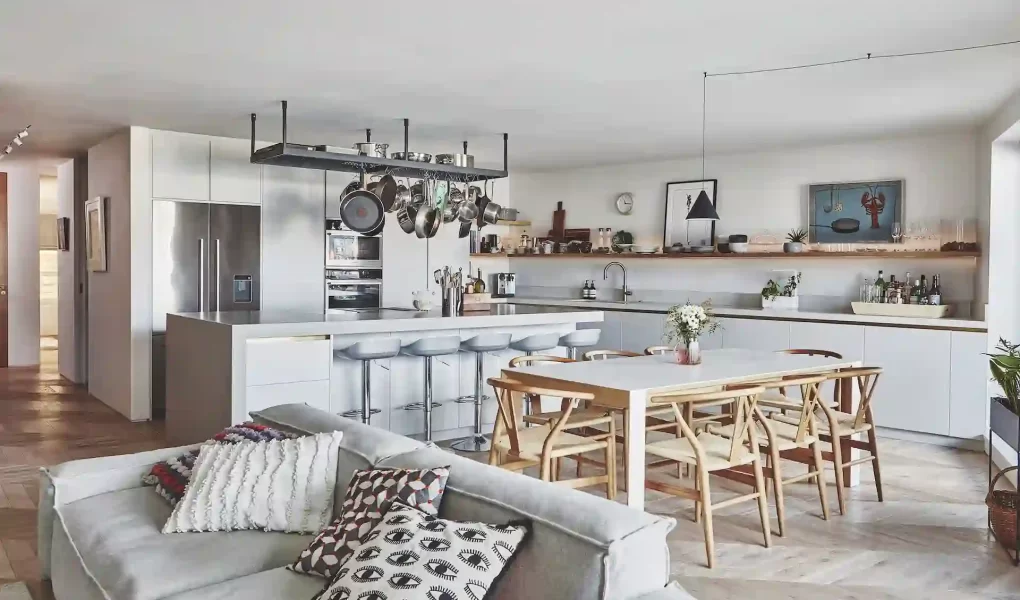Is an open kitchen and living room right for you? The decision comes down to your lifestyle, preferences, and needs. Consider the pros and cons discussed in this article and any specific considerations for your family dynamics. If you enjoy socializing with guests while cooking or prefer a more spacious feel in your home, an open kitchen and living room design could be a great fit. However, alternative options better suit your needs if privacy when cooking or separate designated spaces are essential.
The trend of open kitchen and living room designs
Gone are the days of isolated cooking spaces hidden from the rest of the house. The open kitchen and living room design trend has taken center stage in modern interior design, creating a seamless flow between food preparation and socializing. This layout allows easy interaction with family and guests while whipping up culinary delights.
With open layouts gaining popularity, homeowners opt for airy, light-filled spaces promoting togetherness. By merging the kitchen and living room, natural light can filter through both areas, making them feel more spacious and connected. The design also lends itself to entertaining, as hosts can mingle with guests without missing out on any fun.

Pros of having an open kitchen and living room
One of the significant advantages of having an open kitchen and living room design is the sense of spaciousness it creates. Removing walls can make your home feel more extensive and more inviting. This layout allows for better flow and connectivity between different areas, making it easier to entertain guests or keep an eye on kids while cooking.
Another pro is the social aspect – with an open layout, you can interact with family members or guests while preparing meals. It promotes a sense of togetherness and makes gatherings more inclusive. Natural light from windows in both spaces can filter through without obstructions, creating a bright and airy atmosphere.
An open kitchen and living room also offer flexibility in design options. You can rearrange furniture, add decor elements, or incorporate different color schemes that tie both areas together seamlessly. It’s a versatile setup that suits various interior styles effortlessly.
Cons of open kitchen and living room design
While open kitchen and living room designs appeal, there are some drawbacks. One potential downside is the lack of privacy when entertaining guests or cooking meals. The sounds and smells from the kitchen may permeate the living room, which could be distracting for some individuals.
Another con is the challenge of keeping both spaces clean and organized at all times. With an open layout, messes in the kitchen are visible from the living area, requiring constant tidying up to maintain a cohesive look throughout.
Issues with temperature control can arise in an open-space design. Cooking can generate heat that spreads throughout the combined area, potentially making it uncomfortable during warmer months unless proper ventilation is in place.
If you prefer a more formal dining experience or enjoy hosting dinner parties with a separate dining room ambiance, an open kitchen and living room layout may not provide the formality you desire.
Tips for designing an open kitchen and living room space
When designing an open kitchen and living room space, consider the flow of movement between the two areas. Ensure enough space for people to move around comfortably without feeling cramped.
Lighting is critical in creating a cohesive look in an open-concept space. Use a mix of overhead, task, and ambient lighting to create different moods throughout the day.
Choose cohesive color palettes and materials that harmonize the kitchen and living room. This will help create a seamless transition between the two spaces.
Consider using area rugs to define areas within the open layout, such as dining or seating areas. A rug can also add warmth and texture to a room.
Incorporate storage solutions like built-in cabinets or shelves to keep clutter at bay in the kitchen and living room areas. This will help maintain a clean, organized look in your open-concept space.
Personalize the space with decor elements that reflect your style and personality. These touches can make your open kitchen and living room feel like home, whether it’s artwork, plants, or personal mementos.
Alternative options to consider
When designing your living space, there are various alternatives aside from an open kitchen and living room layout. One option is a semi-open concept where you can have a partially enclosed kitchen that still maintains some connection to the living area.
Another alternative is creating a designated dining area separate from the kitchen and living room. This allows for more privacy during meals while maintaining an open feel in the overall space.
For those who prefer more defined spaces, a traditional closed-off kitchen may be the way to go. This layout separates cooking and socializing areas, benefiting those who like distinct boundaries in their home.
Incorporating sliding doors or room dividers can offer flexibility in your space, allowing you to switch between open and closed layouts as needed. Exploring these alternative options can help you find the perfect balance between openness and privacy in your home design.
Considerations for families with children or pets
When designing an open kitchen and living room space for families with children or pets, there are a few extra considerations to remember.
Safety is paramount. Ensure the design lets you watch your little ones while cooking or relaxing in the living room. Consider adding baby gates or play areas within eyesight.
Durability is key. Choose materials and furniture that can withstand the wear and tear of daily family life. Opt for easy-to-clean surfaces and fabrics that are pet-friendly.
Organization is crucial. With kids’ toys and pet accessories potentially taking up space, ensure there are designated storage areas to keep clutter at bay.
Consider creating separate zones within the open space for different activities like cooking, dining, playing, and relaxing. This helps maintain order in a shared area bustling with family activity.




